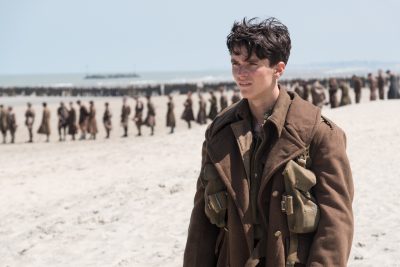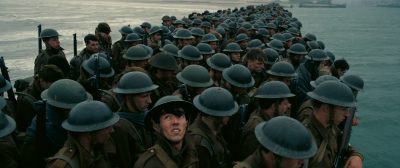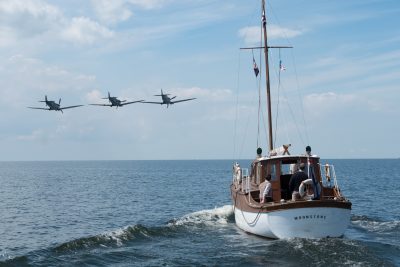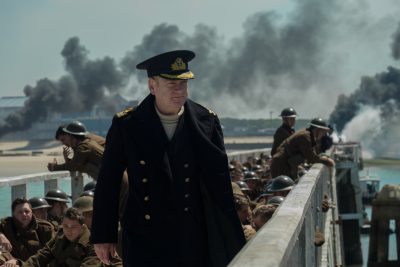
Dunkirk – Tommy (Fionn Whitehead) – Photo by Melinda Sue Gordon/Courtesy of Warner Bros. Pictures
Is it possible for a war movie top give you PTSD?
Christopher Nolan’s Dunkirk, in IMAX, is a harrowing, edge of your seat thriller that practically drags you into the World War II evacuation of over 300,000 soldiers from the beach at Dunkirk.
Nolan interweaves three timelines into Dunkirk: the section that deals with the soldiers stranded on the beach is one week; the section following one of the personal boats that set out to rescue the soldiers takes one day, and the section featuring air support for the stranded soldiers takes one hour.

Dunkirk – Tommy (Fionn Whitehead) – Photo by Melinda Sue Gordon/Courtesy of Warner Bros. Pictures.
If you’re familiar with the way Nolan likes to play with time – as he did so well in Memento, Inception and Interstellar, you will have no trouble making the adjustment as Nolan switches back and forth between timelines.
If not, it shouldn’t take too long to figure it out.
The film opens with a soldier named Tommy (Fionn Whitehead) and a couple other soldiers running through city streets while under fire. Only Tommy makes it to the beach – where he finds almost 400,000 other soldiers standing and waiting to either be cut down by strafing German planes, or rescue (which is more unlikely because none of the British Navy’s destroyers can get close enough to the mile long pier called The Mole for them to get aboard).

Dunkirk – Farrier (Tom Hardy) – Photo by Melinda Sue Gordon/Courtesy of Warner Bros. Pictures.
On the beach, Tommy joins up with Gibson (Aneurin Barnard) and Alex (Harry Styles).
The soldiers only support comers from three Spitfires – one piloted by Tom Hardy.
Back across the Channel, a middle-aged sailor named Dawson (Mark Rylance) and his son Peter (Tom Glynn-Carney) are joined at the last second by Peter’s friend George (Barry Keoghan) as they set out on their pleasure yacht (more like a modern cabin cruiser than a modern yacht) to rescue as many soldiers as they can.

Dunkirk – Dawson’s pleasure yacht – Photo by Melinda Sue Gordon/Courtesy of Warner Bros. Pictures.
Theirs is but one of hundreds of small boats requisitioned by the navy for the rescue attempt.
There’s not much story to Dunkirk – it’s simply small boats set out rescue stranded soldiers with minimal air cover – but that doesn’t matter because Nolan switches from timeline to timeline at the exact moments necessary to build tension and anticipation.
Aided by an atypical score from Hans Zimmer that is haunting one moment and shrieking in terror the next, Nolan builds suspense with his cutaways and momentary highlighting of various characters (Dawson, Peter and George; Tommy, Gibson and Alex; the soldiers on the beach; their distraught but still business-like officers, and the soldiers crammed aboard a Red Cross ship that is bombed before it even gets underway (Nolan never shows a German soldier or swastika, but the bombing of this ship underscores the fact that the Nazis are the bad guys).

Dunkirk – Commander Bolton (Kenneth Branagh) – Photo by Melinda sue Gordon/Courtesy of Warner Bros. Pictures.
IMAX cameras give Nolan a sweeping coverage that makes the film impossible to ignore – though you might want to after a bomb strikes a soldier early on. Nolan doesn’t color the scene with a red mist of blood, but the fact that soldier was there one second and completely obliterated the next has just as profound an effect.
The aerial battles – as the British Spitfires try to keep German bombers from strafing the stranded soldiers or bombing British vessels in the channel – are astonishing. Nolan is on record as saying just how difficult it was to get IMAX cameras into the Spitfires’ cockpits, but the result is intense – and show how difficult it was for a pilot to target an enemy aircraft moving at those speeds.
That the evacuation of over 300,000 soldiers from Dunkirk beach actually happened doesn’t keep Nolan from making a film that keeps its audience on the edge of their seats for the film’s 106 minutes.

Dunkirk – Alex (Harry Styles), Gibson (Aneurin Barnard) and Tommy (Fionn Whitehead) – Photo by Melinda Sue Gordon/Courtesy of Warner Bros. Pictures.
It’s those brief moments with individual characters – just enough time to register their distress, their weariness, their frustration, their awakening hope – that make us forget it’s a true story and keep our attention riveted to the screen.
And, for any One Dimension fans who are worried about it, Styles is as good as anyone else in the cast (a cast that includes Mark Rylance and Kenneth Branagh, so that’s not nothing).
After a series films of varying degrees of brilliance, Christopher Nolan may have just presented us with his masterpiece.
Final Grade: A+